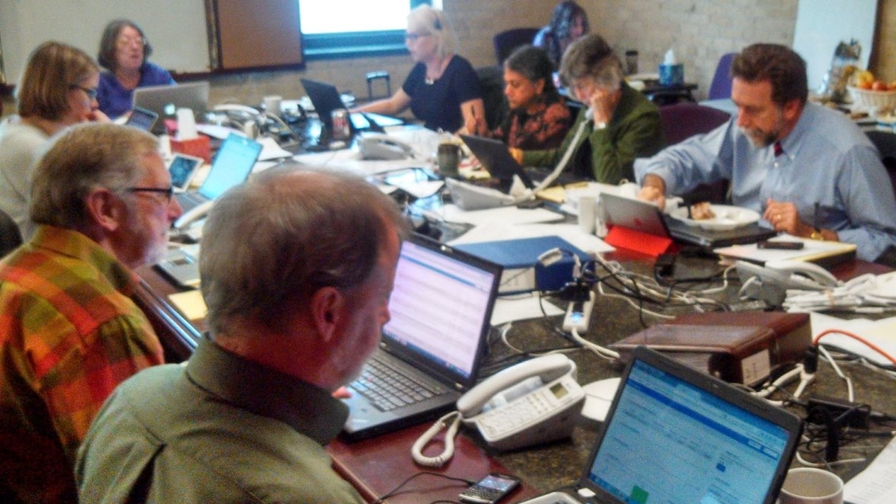Observing Elections and Protecting Voters in Wisconsin
Editorial Note: This guest blog post was written by Carolyn Castore, League of Women Voters of Wisconsin
In a few short years, the League of Women Voters of Wisconsin’s election observer program has grown from a very limited pilot program to a statewide volunteer observer corps that protects voters on Election Day and provides valuable evidence for the Wisconsin League’s ongoing advocacy for clean, accessible elections.
History of our Election Observer Program
Wisconsin is one of the few states where elections are administered at the municipal, not the county, level. With over 1,800 cities, towns and villages, discrepancies were bound to occur. The Wisconsin League decided we needed to understand how elections were run across the state, so we launched our pilot initiative with 15 volunteer observers in 18 polling places across the state in 2010.
The next year, our election observer program was put to the test with the new on-again, off-again voter photo ID law and multiple state senate recall elections. We recruited volunteers statewide, including League members as well as other interested parties. In 2012, we observed both a gubernatorial recall and the November general election. We released a report on our findings from observing the gubernatorial recall that identified five common themes and offered recommendations to better prepare the poll workers for that November’s elections.
We have been able to grow this program thanks to support from the LWVUS’s Public Advocacy for Voter Protection project and our excellent partners here in Wisconsin. We put our program together and recruited volunteers in conjunction with other groups, particularly the Lawyers Committee on Civil Rights, Wisconsin AFL-CIO and the ACLU of Wisconsin.
Observing Election Day 2014
This past Election Day, more than 250 people volunteered as election observers. Some were assigned to stay at one polling place and observe the voting process over a period of several hours, while others were roving observers, visiting four to six polling places throughout the day. In addition to observing polling places, some volunteers staffed hotlines fielding calls from voters, our observers, the media and others who reached us by phone, email or text messages. The polls opened at 7 a.m. and by 7:10 a.m., we were receiving calls. Issues and questions varied:
- Wisconsin has Election Day registration, but recent changes to the law requiring proof of residency upon registration meant that the registration process was more difficult and likely confusing to both voters and poll workers. Lines to register were long around the state, and questions about acceptable documents to prove residency slowed the process further. Our observers were able to work with elections officials to smooth the process, yet many people had to leave without voting because they did not have the right documentation, including a Catholic Priest who was new to his parish.
- A voter photo ID law was passed in 2010, but has yet to be implemented due to looming court cases challenging the law. In September of this year, a federal appeals court ruled it could be implemented for the November elections. In an emergency ruling, the U.S. Supreme Court again postponed implementation, yet confusion among voters and elections officials about the requirements persisted. At a few polling places, poll workers were asking for IDs. At other sites, voters were handing poll workers their IDs and the workers were looking at them, which can cause confusion among those waiting to vote. We were able to intervene successfully in all of these situations and insist that IDs were not to be asked for or accepted. Finally, at other polling places, our observers found signs saying “Photo ID is Optional.” We also worked to get those signs removed.
- Many polling places were understaffed. We were able to put out calls to our membership to get deputized and assist the polling place personnel.
- Though less than the prior years, observers from other organizations were present to disrupt the voting process by challenging poll worker’s decisions as to who may register and vote. We had roving attorneys help with these sites, as well as our own observers.
Throughout the day the lawyers and the Wisconsin League were on Facebook and Twitter—both posting information for voters as well as tracking other posts to provide needed information. We even quashed some rumors—for example one that said police in one town were intimidating voters. For much of the day our phones lines were constantly busy, and I deployed our roving observers to sites that were reporting problems. One couple drove 60 miles in northern Wisconsin to deal with a photo ID problem. Then suddenly the calls quit coming at 7:30 p.m. right before the polls closed at at 8 p.m. We had done all we could to ensure voters’ ability to participate in the democratic process, and we were proud of what we had accomplished.
Many of our volunteers have already said they want to participate again in 2016. Volunteer Janet Finch said “thank you… for this wonderful opportunity to observe and interact with a vast range of citizens, all committed to exercise their right to vote. It was an exhilarating experience.”
Soon, we will receive the written reports from our observers and will begin compiling our final report. We will use it to detail issues to the state Government Accountability Board, a nonpartisan entity that oversees Wisconsin’s elections, and our local Leagues will share it with their local elections officials, many of whom appreciate the League’s evidence-based work and invite us in to discuss the findings. Because of the League’s detailed knowledge of how elections are actually administered, we have made a difference in affecting legal and regulatory changes in election law.
Follow the League of Women Voters of Wisconsin on Facebook and Twitter.
Sign Up For Email
Keep up with the League. Receive emails to your inbox!
Donate to support our work
to empower voters and defend democracy.





